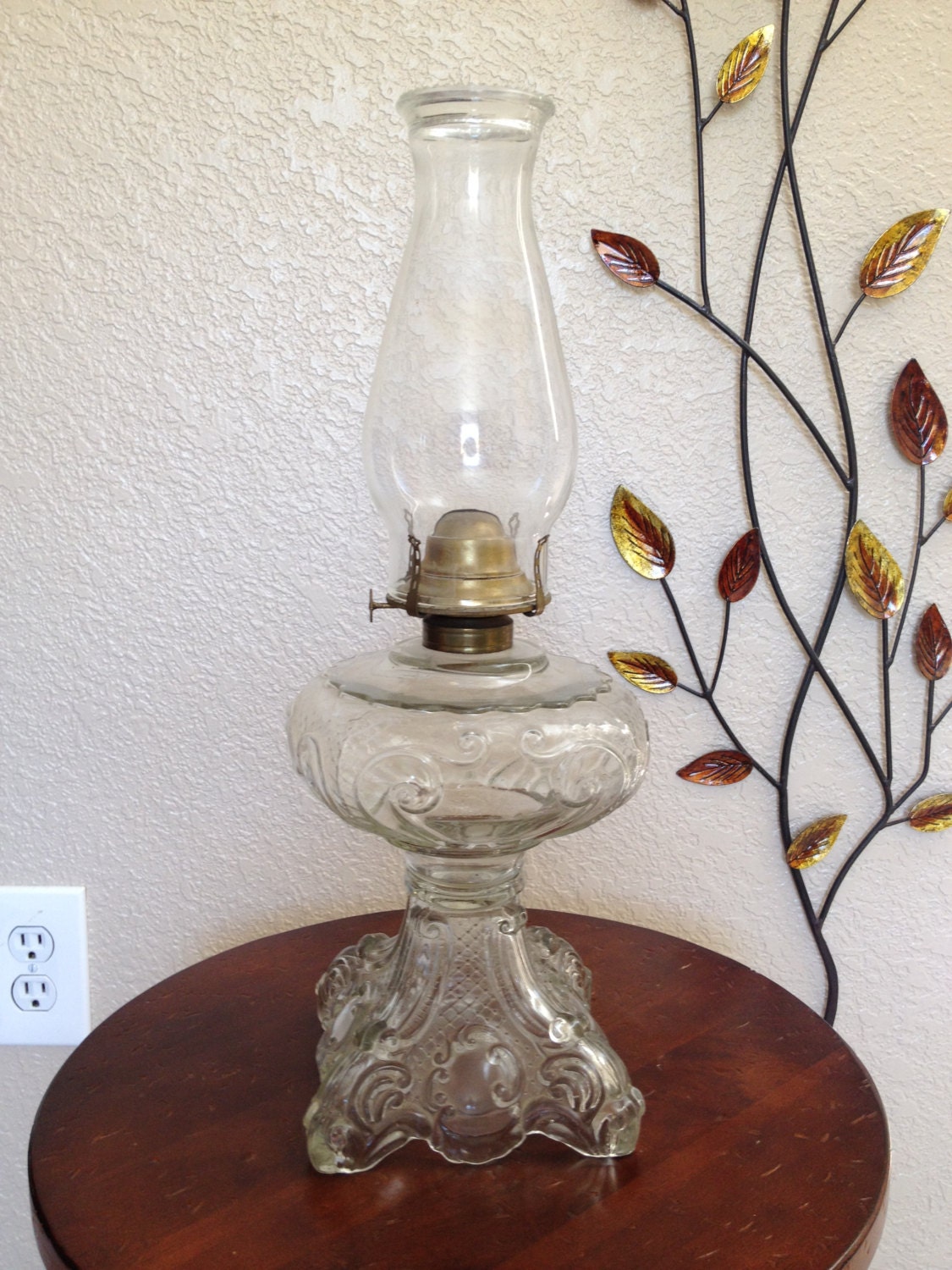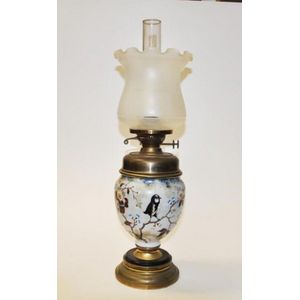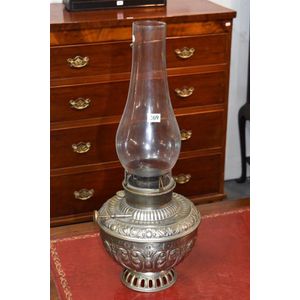Standard Lamp Oil, Synthetic Kerosene, or Kerosene Substitute are recommended for use indoors. Clear K-1 Kerosene with a flash point of 124 to 150 degrees is recommended for outside use. The approved fuels for indoor or outdoor use in Tubular Lanterns and Flat Wick Oil Lamps are: 1.
(c) Vin Callcut 2002-2019.
Small extracts can be used with acknowledgements to 'Oldcopper.org' website.
- They are rather heavy glass lamps, so they are not as prone to chipping as some lamps, but the finishes on several of them are paint. While the glass doesn't chip easily the paint itself can be scratched or chipped. It can also be worn thin from handling, or dulled and stained from kerosene (coal oil) being spilled on the lamp.
- 'Aladdin to Ziu: The Early Kerosene Mantle Lamp in America' by Thomas W. Small and James R. Christner, ISBN 978-0-692-90920-1, does an excellent job of documenting pre-1930 non-pressurized kerosene mantle lamps both made and imported into America. What makes this book unique and important is that it tells the stories of the people and companies.
- Examples of factory-produced oil lamp brands are Coleman, Crown, and Tiki. Buying accessories for oil lamps. Inexpensive oil lamps for sale usually consist of five parts, and most of these accessories can be bought separately on eBay. The most important part is a wick for an oil lamp that absorbs oil and transports it to the burner for ignition.
- Antique Lamp Identification at The Antique Lamp Co and Gift Emporium. Tall Lamps Fabric Shades Lamp Glass Ball Glass Art Perfume Bottles Oil Lamps Kerosene Lamp.
Helpful comments are very welcome.
- Button Makers
- Copper Ores
- Oil Lamp Makers

Oil Lamp Maker's marks are usually to be seen on the wick winder button and occasionally elsewhere. A name on the button identifies the maker of the vital lamp burner. These were made by the specialists for use in lamps made by themselves and also sold for use by others. Founts, chimneys and shades may have been made by others. This list is just a selection of the commonly-found makers found in British markets.
There is an excellent Q & A page for oil lamps on the website of The International Guild of Lamp Researchers. Links to otherlighting related pages
Classic Camp Stove website covers many other makers: http://www.spiritburner.com

European Manufacturers for Kerosene-burners, mostly German, Austrian and French - manufacturers' wick-winder button logos. European Manufacturers
References and Links
The Historic Lighting Club UK, founded 1989, publishes 'Midnight Oil' that includes many specialist articles about four times per year. There are four informal meetings per year in venues in England. It is an invaluable forum for exchange of information.Historic Lighting Club.
Paraffin Antique Lamps Net, includes links to more than 20 other lamp sites.
The Origin and Development of the Incandescent Paraffin Lamp, A. R. J. RAMSEY, C.P A. Trans. Newcomen Society Vol 41 (1968) pp001-026.
Pressure Lamps Unlimited.
Current European Manufacturers of gaslights and kerosene-lamps.
References
Many good books are listed by The Lampworks.
There are many commercial suppliers of lamps and spares also to be found with good websites.
Aladdin, Originally the Mantle Lamp Company, USA. Their first Aladdin lamp was produced in 1909. See: Aladdin Lamps.
Albion Lamp Company, Aston Booth Lamp Works, Aston, Birmingham. More information wanted.
Beacon Light - see Smith and Davis.
Benham and Froud Benham and Froud
W A S Benson and Co Benson.
Benton & Stone, Bracebridge Street (ENOTS), by 1926 also at Aston Brook Street, art metal workers and makers of gas fittings, garden syringes and sprays and motor accessories. Trade Mark 'ENOTS'. This photo by Peter Grantham.
Birmingham Brass Co., Conn. USA Birmingham Brass USA.
Thos. Edward Bladon & Son, 4, James St., Birmingham (1886), 46, 99 & 101,Northwood Street, Hockley, Birmingham,(previously John Bladon of Constitution Hill (K1829), then William Erhard Bladen, c1905) makers of cart lamps. tinplate and blowlamps.
Brevetes L & B -see Lempreur & Bernard, Lampes Belges, below.
Bullpitt & Sons, 46, Northwood Street, Birmingham, later 153, Camden Street, taken over by BSR Group in the 1970's. Made lamps, copper presswork for kettles, lamps etc., later 'Swan' Brand kettles.
Burmos - Towson & Coxson, Alliance Works, Esington Street., gas fittings, Burmos stoves and blowlamps.
Eltex - Trade name of George Elt Ltd. of Worcester. They made heaters used for greenhouses and elsewhere, frequently with burners from other makers.
These winder knobs are on a duplex lamp burner.
Erich & Graetz, Berlin, originators of the Matador burner.
Eight pointed star used on many burners, especially those supplied to other lamp manufacturers. This is on a filler cap, the winder knob shown below.
Winder button on an Erich and Graetz lamp. See other European Manufacturers.
Evered & Co., Surrey Works Lewisham Road, Smethwick. trademark shield with RE&S inside, E&C underneath, bedsteads, gas and electric fittings, solid and brass cased steel tubes.
These marks are on oil lamps, (courtesy Alex Marrack).
Winder buttons on an Evered No3 duplex burner. Evered & Co Ltd, London & Birmingham. (Thanks to Elaine Barclay)
Falk Stadelmann & Co., Veritas House, Lionel Street, Birmingham, suppliers of oil lamps and components. Originally a German firm, they later incorporated Veritas, Wright and Butler (c1912), Palmer & Co. of London, W Williams & Son of Birmingham and, by 1933, James Hinks & Son but continued use of the old trade names for some time. Their main warehouse depot was at Veritas House, 83-93 Farringdon Road, London by the late 1930s. They became the largest lamp makers in ther UK and in 1930s the firm employed around 3,000 people. Falk Stadelmann's ceased had trading by the late 1960s and was taken over by Jessel Investments, who sold off all property and ceased manufacturing activities.
Famos - brand name used by Falk Stadelmann.
Gardun, Macon, France.
Joseph Hinks & Son, 91-96 Great Hampton Street & 66 Hockley Street, Birmingham. Hinks.
Howes & Burley, Birmingham, automotive lamp manufacturers.

Kosmos Brenner, a distinctive circular burner that comes with a tall narrow chimney with patent 'pinch'.
Kynoch Ltd., Lion Works, Witton, originally early 19th century candlemakers but diversified to lamps and eventually pressure stove for paraffin (kerosene). They later became part of ICI Metals Division, then IMI plc.
Lampe Nationale, brand name of Lewtas, Mcr, details to be added. The Design Registration number 155641 is on the filler cap of a fount with circular wick. Interestingly, that number was issued to May and Padmore of Birmingham on the 2nd September 1890.
Lempreur & Bernard, Lampes Belges, maker of paraffin lamps and gas fittings with characteristic circular burners. Trade mark 'L & B' and sun seen on wick winders.
Lucas, Harry, then Joseph Lucas & Co. Ltd. Great King Street, Birmingham, making lamps since 1876. This makers plate is on a 'King of the Road' oil lamp.
Samuel S Messenger & Sons. Founded before 1835 in Gloucester Place, Alston Street, Birmingham, moved to 19&20 Broad Street, making candelabra, lamps and gas fittings, exhibitor at 1851 Great Exhibition and others. The name occurs in the 1810s as Messenger and Phipson of Broad Street, Birmingham, manufacturers of plated goods. Messenger.
Midland Lighting Co, 7, Corporation Street, Birmingham with Sun Lamp Works, Leopold Street, Birmingham until about 1905, using the 'In Lux Way' trademark, manufacturers and agents for Thermidor Belge centre draft burners.
Edward Miller Co., Meriden, CT. started in the 1844 by Horation N Howard but taken over in 1845 by Edward Miller.
Monitor Engineering & Oil Appliances Ltd. Based in Stechford, Birmingham, England, making stoves & blowlamps. They were owned from an early stage by W. Parkinson & Co., later incorporated into Parkinson Cowen Ltd, manufacturers of gas meters, central heating systems & domestic cookers. Parkinson Cowen later became part of the British corporate giant Thorn EMI before being sold to Swedish company Electrolux in 1987 and subsequently closed. Photo to come.
Powell and Hanmer, P & H Ltd., Chester Street, Aston Manor, Birmingham (1929), 4, Ernest Street, B1 machined components, motor accessories including carbide/acetylene and electric lamps. (Photo thanks to Colin Ansell).
Rippingilles, 'The Never Fail'. details to be added

The Rochester Lamp Companyfounded in 1844 by Charles Stanford Upton using a patent for an improved air distribution in centre-draft lamps. Address 42 Park Place and 37 Barclay Street, New York City and branches in London, Paris and Chicago. From 1884 to 1892 they were made by Edward Miller and Company. Thereafter they were made as 'New Rochester' lamps by The Bridgeport Brass Co.
Shaw, John Shaw & Sons Ltd, Wolverhampton, used a 'Governor' Trade Mark and a 'J.S.S.' mark on their blowlamps and other items. See: John Shaw and Sons. This 'JS&S' mark should not be confused with Joseph Sankey.
S. H. S., this button one of a pair on a duplex lamp. Samuel Heath & Sons, Birmingham.
Sherwoods Ltd., manufacturers of oil lamps and burners in Birmingham. In 1904 they were trading as Sherwood Isaac & Son Ltd., but by 1920 they had taken over Linley & Co. of 73-75 Great Lister Street, ‘American’ pattern lamps to become Sherwood-Linley. Nechells Park Works, Eliot Street, Nechells then moved to 44-50, Granville St. Sherwoods.
Thermidor Belge, sold in the UK by Midland Lamp Co.
Tilley International plc., 30-32 High Street, Frimley, GU16 5JD. Tilley was established in the early part of the 19th century. A family business that brought practical, low cost light and heating to the world. These pressure lamps generate a number of keen product enthusiasts.

Towson & Coxson, Alliance Works, Essington Street, Birmingham, gas fittings, Burmos stoves and blowlamps. Photo to come.
Valor Co., Ltd., 67, 69-72 Church Street, Birmingham, stampers and piercers. (1901), later the 'The Valor Co.', Aston Brass Co., Wood Lane, Bromford, Birmingham, makers of oil lamps and stoves. This shows the Valor shield inside an address plate under a room heater burner. (ack Michelle Von Memerty) Veritas Valor.
Vapalux, Trade name of Willis and Bates of Halifax first used in 1938. In 1897, Alfred Bates relocated his metal spinnings company, Willis & Bates, to Halifax, Yorkshire, to serve the northern textile regions . Main products were street lighting units, spinnings for gas heated geysers and associated items. They soon expanded into the rapidly developing electrical industry, making mainly for General Electric Company and Holophane Ltd. and, after 1918 also components for Falk Stadelman Ltd and Drysdale Ltd (of Glasgow). From 1925 until 1938, all the lamp pressings used by Tilley, along with a floodlight, are designed and produced by Willis & Bates. The 'Vapalux' trade name was registered in 1938 for their own pressure lamps. After the war, work continued with many of Willis & Bates' pre-war customers, with the addition of Stotts of Oldham, Aladdin Industries, Allied Ironfounders Ltd and the Ministry of Defence. The lantern was marketed by Aladdin Industries under the trade name Bialaddin until 1970 when Willis and Bates started marketing again under the Vapalux brand. Willis and Bates was bought out by Bairstow Brothers (1985) Ltd., a Halifax family firm founded in the late 19th Century.
Antique Glass Kerosene Lamps
A
